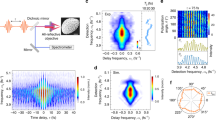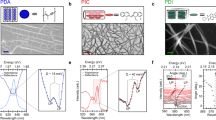Abstract
The manipulation of radiative properties of light emitters coupledwith surface plasmons is important for engineering new nanoscale optoelectronic devices, including lasers, detectorsand single photon emitters1,2,3,4,5,6,7,8. However, so far the radiative rates of excited states in semiconductors and molecular systems have been enhanced only moderately, typically by a factor of 10–50, producing emission mostly from thermalizedexcitons2,6,9,10,11. Here, we show the generation of dominant hot-exciton emission, that is, luminescence from non-thermalized excitons that are enhanced by the highly concentrated electromagnetic fields supported by the resonant whispering-gallery plasmonic nanocavities of CdS–SiO2–Ag core–shell nanowire devices. By tuning the plasmonic cavity size to match the whispering-gallery resonances, an almost complete transition from thermalized exciton to hot-exciton emission can be achieved, which reflects exceptionally high radiative rate enhancement of >103 and sub-picosecond lifetimes. Core–shell plasmonic nanowires are an ideal test bed for studying and controlling strong plasmon–exciton interaction at the nanoscale and opens new avenues for applications in ultrafast nanophotonic devices.
This is a preview of subscription content, access via your institution
Access options
Subscribe to this journal
Receive 12 print issues and online access
$259.00 per year
only $21.58 per issue
Buy this article
- Purchase on Springer Link
- Instant access to full article PDF
Prices may be subject to local taxes which are calculated during checkout




Similar content being viewed by others
References
Barnes, W. L., Dereux, A. & Ebbesen, T. W. Surface plasmon subwavelength optics. Nature 424, 824–830 (2003).
Schuller, J. A. et al. Plasmonics for extreme light concentration and manipulation. Nature Mater. 9, 193–204 (2010).
Mühlschlegel, P., Eisler, H-J., Martin, O. J. F., Hecht, B. & Pohl, D. W. Resonant optical antennas. Science 308, 1607–1609 (2005).
Atwater, H. A. & Polman, A. Plasmonics for improved photovoltaic devices. Nature Mater. 9, 205–213 (2010).
Noginov, M. A. et al. Demonstration of a spaser-based nanolaser. Nature 460, 1110–1112 (2009).
Ma, R-M., Oulton, R. F., Sorger, V. J., Bartal, G. & Zhang, X. Room-temperature sub-diffraction-limited plasmon laser by total internal reflection. Nature Mater. 10, 110–113 (2011).
Min, B. et al. High-Q surface-plasmon-polariton whispering-gallery microcavity. Nature 457, 455–458 (2009).
Akimov, A. V. et al. Generation of single optical plasmons in metallic nanowires coupled to quantum dots. Nature 450, 402–406 (2007).
Okamoto, K. et al. Surface-plasmon-enhanced light emitters based on InGaN quantum wells. Nature Mater. 3, 601–605 (2004).
Biteen, J. S., Pacifici, D., Lewis, N. S. & Atwater, H. A. Enhanced radiative emission rate and quantum efficiency in coupled silicon nanocrystal-nanostructured gold emitters. Nano Lett. 5, 1768–1773 (2005).
Anger, P., Bharadwaj, P. & Novotny, L. Enhancement and quenching of single-molecule fluorescence. Phys. Rev. Lett. 96, 113002 (2006).
Conradi, J. & Haering, R. R. Oscillatory exciton emission in CdS. Phys. Rev. Lett. 20, 1344–1346 (1968).
Yang, C. H., Carlson-Swindle, J. M., Lyon, S. A. & Worlock, J. M. Hot-electron relaxation in GaAs quantum wells. Phys. Rev. Lett. 55, 2359–2361 (1985).
Wiesner, P. & Heim, U. Dynamics of exciton-polariton recombination in CdS. Phys. Rev. B 11, 3071–3077 (1975).
Permogorov, S. Hot-excitons in semiconductors. Phys. Status Solidi B 68, 9–42 (1975).
Zhao, H., Moehl, S. & Kalt, H. Coherence length of excitons in a semiconductor quantum well. Phys. Rev. Lett. 89, 097401 (2002).
Fedutik, Y., Temnov, V. V., Schops, O., Woggon, U. & Artemyev, M. V. Exciton-plasmon-photon conversion in plasmonic nanostructures. Phys. Rev. Lett. 99, 136802 (2007).
Dong, Z. C. et al. Generation of molecular hot electroluminescence by resonant nanocavity plasmons. Nature Photon. 4, 50–54 (2010).
Oulton, R. F. et al. Plasmon lasers at deep subwavelength scale. Nature 461, 629–632 (2009).
van Vugt, L. K. et al. Variable temperature spectroscopy of as-grown and passivated CdS nanowire optical waveguide cavities. J. Phys. Chem. A 115, 3827–3833 (2011).
Thomas, D. G. & Hopfield, J. J. Exciton spectrum of cadmium sulfide. Phys. Rev. 116, 573–582 (1959).
Gross, E., Permogorov, S., Travnikov, V. & Selkin, A. Hot-excitons and exciton excitation spectra. J. Phys. Chem. Solids 31, 2595–2606 (1970).
Nusimovici, M. A., Balkanski, M. & Birman, J. L. Lattice dynamics of wurtzite: CdS. II. Phys. Rev. B 1, 595–603 (1970).
Gross, E., Permogorov, S., Morozenko, Y. & Kharlamov, B. Hot-exciton luminescence in CdSe crystals. Phys. Status Solidi B 59, 551–560 (1973).
Pelekanos, N. et al. Hot-exciton luminescence in ZnTe/MnTe quantum wells. Phys. Rev. B 43, 9354–9357 (1991).
Agarwal, R. & Lieber, C. M. Semiconductor nanowires: Optics and optoelectronics. Appl. Phys. A 85, 209–215 (2006).
Maier, S. A. Plasmonics: Fundamentals and Applications (Springer, 2007).
Purcell, E. M. Spontaneous emission probabilities at radio frequencies. Phys. Rev. 69, 681 (1946).
Fleming, G. R. Chemical Applications of Ultrafast Spectroscopy 124–224 (Oxford, 1986).
Johnson, P. B. & Christy, R. W. Optical constants of noble metals. Phys. Rev. B 6, 4370–4379 (1972).
Palik, E. D. Handbook of Optical Constants of Solids (Academic, 1998).
Acknowledgements
We thank N. Engheta for discussions and A. Exarhos for helping to build the optical Kerr gate system. Time-resolved photoluminescence work was supported by the Department of Energy BES under Award No. DESC0002158. The remaining work was supported by the US Army Research Office under Grant No. W911NF-09-1-0477, National Institutes of Health through the NIH Director’s New Innovator Award Program, 1-DP2-7251-01, and the Nano/Bio Interface Center through NSF-NSEC-DMR08-32802. C.O.A. is supported by the NBIC through the NSF IGERT DGE02-21664.
Author information
Authors and Affiliations
Contributions
C-H.C. and R.A. developed the concept and design of the devices. C-H.C. carried out the device fabrication and steady-state optical measurements. C.O.A. performed the numerical simulations. M.E.T. and J.M.K. performed the time-resolved photoluminescence measurements. S-W.N. performed the transmission electron microscope measurement. C-H.C., C.O.A. and R.A. analysed the results and wrote the manuscript.
Corresponding author
Ethics declarations
Competing interests
The authors declare no competing financial interests.
Supplementary information
Rights and permissions
About this article
Cite this article
Cho, CH., Aspetti, C., Turk, M. et al. Tailoring hot-exciton emission and lifetimes in semiconducting nanowires via whispering-gallery nanocavity plasmons. Nature Mater 10, 669–675 (2011). https://doi.org/10.1038/nmat3067
Received:
Accepted:
Published:
Issue Date:
DOI: https://doi.org/10.1038/nmat3067
This article is cited by
-
Hyperbolic whispering-gallery phonon polaritons in boron nitride nanotubes
Nature Nanotechnology (2023)
-
Theoretical analysis of a circular hybrid plasmonic waveguide to design a hybrid plasmonic nano-antenna
Scientific Reports (2020)
-
Loss compensation of surface plasmon polaritons in organic/metal nanowire heterostructures toward photonic logic processing
Science China Materials (2020)
-
Artificial neural networks enabled by nanophotonics
Light: Science & Applications (2019)
-
Mie-coupled bound guided states in nanowire geometric superlattices
Nature Communications (2018)



